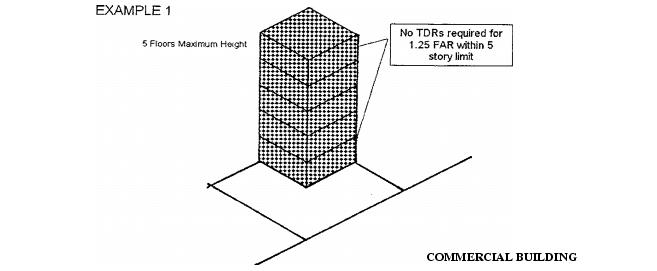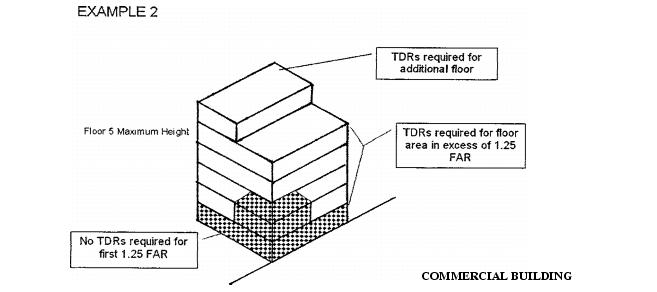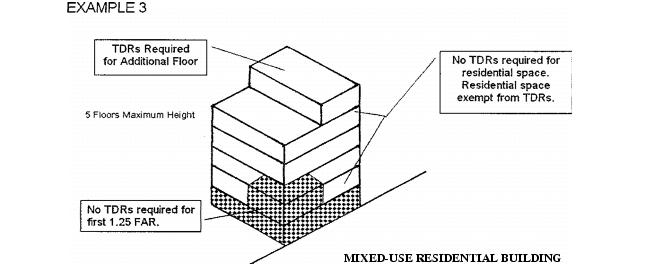20C.40.40 Site Requirements.
20C.40.40-010 General.
Except as otherwise provided in this division, all applicable provisions of the Community Development Guide and other applicable codes and ordinances apply to development in the Downtown districts. (Ord. 2302; Ord. 1901)
20C.40.40-020 Site Requirements.
The Downtown Districts Site Requirements Chart, RCDG 20C.40.40-045, sets forth other dimensional and site requirements for districts within Downtown as shown in the Downtown Districts Map, RCDG 20C.40.20-015. Each structure, development or activity in the district must comply with these requirements. (Ord. 2302; Ord. 1901)
20C.40.40-030 Administrative Design Flexibility (ADF).
The purpose of this section is to promote creativity in site layout and design, and to allow flexibility in the application of standards for commercial, office, retail, mixed-use and residential development within the Downtown neighborhood, and to achieve the creation of sites and uses that may benefit the public by the application of special design policies and standards not otherwise possible under conventional development regulations and standards. Departure from standards included in this section may be permitted as part of the site plan entitlement process.
(1) Deviations from these standards may be allowed if an applicant demonstrates that the deviations from the standards would result in a development that:
(a) Better meets the intent of the goals and policies for the design area in which the site is located;
(b) Is superior in design in terms of architecture, building materials, site design, landscaping and open space; and
(c) Provides benefit to the Downtown neighborhood in terms of desired use, activity, and design.
(2) ADF – Flexibility of Design Standards in Downtown. Requirements of RCDG Title 20C, Land Use Regulations, that may be modified by application of this subsection are defined specifically as follows:
(a) Parking Lot Location. Requirements for the location of on-site parking lots may be modified within the development (except for parking within residential yard areas) to provide for greater joint-use and quasi-public parking opportunities and uses which are highly desirable in the subject design area.
(b) Mid-Block Pedestrian Walkways and Vehicular Lanes. Requirements for mid-block pedestrian and vehicular lanes per RCDG 20C.40.105, Downtown Pedestrian System, may be modified to allow variations in locations and minimum widths for these items to provide superiority in site design and function which benefits both the property owner and public.
(c) Street standards for townhouse subdivision developments.
(d) Other Site Requirements and Standards. All other site requirements and standards for Downtown except density, number of stories, and FAR may be modified within the development to provide superiority in site design, i.e., greater amounts of privacy, maintenance of views, preservation of vegetation, provision of usable open space, adequate light, air, and security. (Ord. 2302; Ord. 2271; Ord. 1901)
20C.40.40-040 Maximum FAR and Height without TDRs.
(1) This section, in conjunction with the Downtown Districts Site Requirements Chart, RCDG 20C.40.40-045, sets a maximum floor area ratio (FAR) for all Downtown developments, unless the development transfers floor space through the Transfer of Development Rights (TDR) program authorized by Chapter 20D.200 RCDG. The maximum FAR applies to the gross floor area of all buildings on the site, excluding parking areas for motor vehicles which are not maintained as a stock in trade. See exceptions and examples on the next pages.
(2) Exceptions.
(a) Regardless of the maximum FAR without TDRs allowed in the Downtown Districts Site Requirements Chart, RCDG 20C.40.40-045, all buildings shall be allowed at least 10,000 square feet of gross floor area. It shall not be necessary to transfer development rights to the site under the Transfer of Development Rights program to be entitled to the minimum amount of 10,000 square feet of space allowed by this subsection.
(b) Transfer development rights are not required for residential floor area within the maximum building height.
(c) Buildings may add one floor beyond the maximum building height standard through the use of TDRs for height per Chapter 20D.200 RCDG, Transfer and Purchase of Development Rights (TDR) Program. See also RCDG 20C.40.35-020, Building Height Restrictions.
EXAMPLES: The examples below illustrate whether transfer development rights (TDRs) are required or not.
1. A maximum floor area ratio (FAR) of 1.25 commercial floors is the maximum development that can be achieved without purchasing TDRs, as the first 1.25 FAR is exempt from TDR requirements.
2. A five-story, 5.0 FAR commercial building can be achieved by purchasing TDRs for the floor area in excess of 1.25 FAR (shaded floor area in diagram). A six-story, 5.50 FAR commercial building can be achieved by purchasing TDRs for the additional sixth floor area.

3. Residential floor area is exempt from TDR requirements per subsection (2)(b) of this section. The area that is not shaded represents residential floor area in a mixed-use building. Additionally, the first 1.25 FAR is exempt from TDR requirements. Where five stories is the maximum allowed height, a sixth story may be added with the purchase of TDRs for the additional floor area above the fifth floor (one additional floor only).
(Ord. 2302; Ord. 1901)
20C.40.40-045 Site Requirements.
|
DOWNTOWN DISTRICTS |
Old Town |
Town Center |
Valley View Bear Creek Trestle |
Town Square |
Sammamish Trail Anderson Park |
River Bend |
River Trail East Hill Carter |
|
Design Criteria |
See Ch. 20D.40 |
See Ch. 20D.40 |
See Ch. 20D.40 |
See Ch. 20D.40 |
See Ch. 20D.40 |
See Ch. 20D.40 |
See Ch. 20D.40 |
|
Residential Densities Maximum Number of Dwelling Units Per Gross Acre |
See Table 20C.40.45-020 |
See Table 20C.40.45-020 |
See Table 20C.40.45-020 |
See Table 20C.40.45-020 |
See Table 20C.40.45-020 |
See Table 20C.40.45-020 |
See Table 20C.40.45-020 |
|
Minimum Yard Setbacks |
|
|
|
|
|
|
|
|
Front Street (in feet) 1 |
14' 2, 2a |
See footnote 3 |
20' 1a, 2a |
14' 2, 2a |
14' 2, 2a |
20' 2a, 2b |
25' 2a |
|
Side Street (in feet) 1 |
14' 2 |
See footnote 3 |
20' 1a |
14' 2 |
14' 2 |
20' 2c |
25' |
|
Side Yard (in feet) 1b |
0' |
See footnote 3 |
0' |
0' |
0' |
0' 2c |
See RCDG 20C.40.55-050 |
|
Side Yard (in feet) – Residential uses |
See RCDG 20C.40.55-050 |
See RCDG 20C.40.55-050 |
See RCDG 20C.40.55-050 |
See RCDG 20C.40.55-050 |
See RCDG 20C.40.55-050 |
See RCDG 20C.40.55-050 |
See RCDG 20C.40.55-050 |
|
Rear Yard (in feet) 1b |
0' |
See footnote 3 |
0' |
0' |
0' |
0' 2c |
10' |
|
Rear Yard (in feet) – Residential uses above ground floor commercial |
10' |
10' 3 |
10' |
10' |
10' |
10' 2c |
10' |
|
Yard Adjoining Residential District (in feet) |
5' |
5' 3 |
5' |
5' |
5' |
5' 2c, 4 |
5' |
|
Yard Adjoining BNSF ROW or Parks |
14' |
14' |
14' |
14' |
14' |
14' |
14' |
|
Between Buildings On-Site (in feet) |
N/A |
See footnote 3 |
N/A |
N/A |
N/A |
N/A |
2 times side yard |
|
Parking |
See footnote 5 |
See footnote 3 |
See footnote 5 |
See footnote 5 |
See footnote 5 |
See footnote 5 |
See RCDG 20C.40.85 |
|
Maximum Building Height (Stories)9, 9a |
5 9b, 14 |
See footnotes 8, 9b |
210 |
5 6, 7, 9b |
5 9b |
5 9b |
4 9b |
|
Maximum Height Within Shorelines9c, 9d, 9e (SMP) |
35' |
35' |
35' |
N/A |
35' |
N/A |
35' |
|
Lot Coverage 11a, 11b |
100% |
See footnote 11 |
80% |
100% |
100% |
100% |
See Table 20C.40.45-020 |
|
Parking Spaces Required |
12 See 20D.130 |
See 20D.130 |
13 See 20D.130 |
See 20D.130 |
12,13 See 20D.130 |
See 20D.130 |
See 20D.130 |
|
Maximum FAR without TDRs See RCDG 20C.40.40 |
1.25 |
See footnote 15 |
1.0 |
1.25 |
1.25 |
1.25 |
1.25 |
Notes:
1 Measured from back of curb. See also RCDG 20C.40.105, Downtown Pedestrian System. See also RCDG 20D.210.25, Sight Clearance at Intersections.
1a Thirty feet, if designated per RCDG 20C.40.105, Downtown Pedestrian System.
1b Measured from property line. In case of alley, measured after dedication, if necessary.
2 On streets fronting Type V pedestrian walkways per RCDG 20C.40.105, 14 feet is the average required. Building fronts shall be developed to the sidewalk and/or plaza edges.
2a Front setback for residential use above ground floor commercial shall be regulated by RCDG 20C.40.105, Downtown Pedestrian System.
2b Where a grove of trees (six or more significant trees within a quarter-acre area) lie along a street front, the setback shall be 100 feet. Otherwise the setback shall be per RCDG 20C.40.105, Downtown Pedestrian System.
2c Where a grove of trees (six or more significant trees within a quarter-acre area) stands on the heron rookery site, the setback shall be 30 feet to preserve the trees. Otherwise the setback shall be zero feet.
3 All new development shall comply with the adopted Town Center Master Plan and Design Guidelines.
4 Within 100 feet of adjoining Residential districts, bay doors other than for loading may not open directly toward (without a building in between) the residential district.
5 Governed by RCDG 20D.130.10-030(15), Parking Area Location and Design Criteria in the Downtown Neighborhood.
6 Five stories is maximum height without bonus. Bonus to eight stories granted for provision of 20 percent on-site usable open space in the form of plazas/arcades with water features that are accessible to public during extended business hours, public meeting rooms, day care services, or the preservation of historic buildings or sites. The amenities shall be on the project site or within the design district in which the building is located. Such approval shall be granted through the site plan review process. TDRs may not be used to exceed the eight-story height allowed through these bonuses.
7 Height limit overlay districts may apply; see RCDG 20C.40.35, Height Limit Area.
8 Mixed-Use area: four stories; hotel – six or eight stories with meeting, conference and banquet facilities. Office Park area: five stories. Bear Creek Retail Area: three stories. Mixed-use residential or residential use in Town Center: five stories outright. The Technical Committee shall administratively allow the height in the Mixed-Use overlay area to be increased to six stories if the building facade is recessed above the second floor and building modulation is provided to mitigate the bulk and mass from the additional height allowance.
9 Heating, cooling and ventilation equipment, elevator penthouses, rooftop exits, and flag poles may exceed the height limit by not more than an average of 15 feet. Building designs with extra-tall parapet walls or architectural features may be allowed with Design Review Board approval.
9a The maximum building height on a site may be exceeded, as a trade-off, when building height reductions are required at the building edges, along a street or park, to achieve better design and stepped building height through the design review process. The amount of floor area that is allowed to exceed the prescribed maximum building height (without transfer development rights or bonuses) shall not exceed the floor area that was removed or omitted to create the stepping building facade, and shall not exceed one additional floor above the maximum prescribed building height.
9b One floor of additional height may be achieved with the use of transfer development rights per Chapter 20D.200 RCDG, Transfer and Purchase of Development Rights (TDR) Program, except they may not be used to exceed eight stories where eight stories is allowed through bonus provisions. See also RCDG 20C.40.40-040, Maximum FAR and Height without TDRs, and RCDG 20C.40.35-020, Building Height Restrictions.
9c Water-enjoyment uses within the shoreline jurisdiction may exceed this height limit up to a maximum of 60 feet, or the maximum specified by the underlying zone, whichever is less, when approved through a Shoreline Conditional Use Permit. (SMP)
9d This height limit is restricted to that portion of the building physically located within the shoreline jurisdiction. (SMP)
9e The maximum height of structures, including bridges, that support a regional light rail transit system may be higher than 35 feet but shall be no higher than is reasonably necessary to address the engineering, operational, environmental and regulatory issues at the location of the structure. (SMP)
10 The maximum height may be increased to four stories when the site’s development plan can demonstrate the goals and objectives outlined in Comprehensive Plan Policy DT-49, and the design guidelines outlined in RCDG 20D.40.110-020(3) are met through the site plan entitlement process.
11 Governed by RCDG Title 20B, Downtown Element, Town Center District Goals and Policies, and Town Center Master Plan and Design Guidelines.
11a For residential development without ground floor commercial/office, lot coverage shall be governed by RCDG 20C.40.45-020.
11b Lot coverage percentage equals: The total site area measured to the property line, less pedestrian systems measured to the curb line, on-site sidewalks, landscaping, and plazas, divided by the site area measured to the curb line.
12 A density bonus for contribution to In-Lieu Parking Fund is available per RCDG 20D.130.10-040.
13 Surface parking is prohibited within 150 feet of the river’s top-of-bank.
14 When properties front on Leary Way and are within the three-story height limit overlay shown on the Downtown Height Limit Overlays Map, RCDG 20C.40.35-020, the maximum building height shall be three stories.
15 The maximum gross leasable area of allowed commercial space without TDRs is 1.49 million square feet. The 1.49 million square feet limit may be increased to a maximum of 1.80 million square feet through the acquisition and use of TDRs, provided that TDRs may not be used to increase the height of the full service hotel/conference center above eight stories/100 feet, and that a minimum of 140,000 square feet be reserved for a full service hotel/conference center with banquet and meeting facilities to accommodate groups of at least 300 people. The additional square footage allowed may be used for infill retail and general service uses that are part of mixed-use residential developments or infill developments. Floor area for residential uses is exempt from TDR requirements and maximum commercial floor area limitations.
(Ord. 2486; Ord. 2302; Ord. 2114; Ord. 2080; Ord. 2051; Ord. 1992; Ord. 1901)
20C.40.40-050 Reserved.
(Ord. 2302; Ord. 2027)


